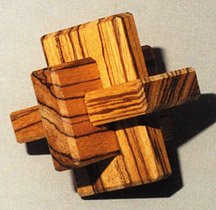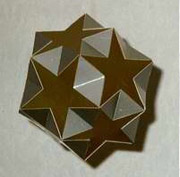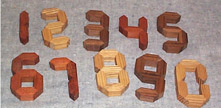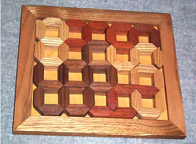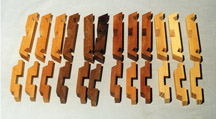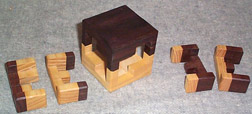
Faithful readers of the online woodworking forum WoodCentral.com may well remember a somewhat cryptic but decidedly sad announcement by one of the site’s beloved regular contributors whose work was both highly unusual and highly respected. For years, Steve Strickland owned a very successful business making three-dimensional wooden puzzles so precise and complex that it hurt the brain to even think about them. He sold them all over the world.
Then, one day, in what seemed an odd decision to those who knew him as an online entity, he abruptly closed his business citing, of all things, political reactions. Steve’s puzzling story involves the fateful events of 9/11 and a thriving American business completely wiped out by the war in Iraq, but it will make more sense if we start at the beginning.
Steve’s woodworking business came about relatively late in his career and quite serendipitously. “After high school, I went to work for a printing company in Dallas, Texas,” Steve recounted, “and did that for 25 years until 1995. The reason I got out of it is because the computer totally turned the printing industry on its ear. What I was doing at 25 dollars an hour was being replaced by 8 dollar an hour computer technicians. At the same time, the Internet was coming on strong, and I was really attracted to that. I was convinced that computers would put a huge dent into the budgets companies had for the printing business and felt it was time to leave and go into the Internet industry. I went out on my own as an Internet consultant, and got plenty of work doing that, but I found it unpleasant. I was sweeping up people’s messes and fixing other people’s problems.
“Even early in my printing career, I always had an interest in creating polyhedra, or regular three-dimensional shapes. As a printer, I had access to really great paper and could get it for free. I started building all sorts of three-dimensional polyhedral models out of stiff paper. One day at a used book store I came across a book called The Puzzling World of Polyhedral Dissections. I started to realize what this guy was really talking about was three-dimensional geometric puzzles.
“I had been doing some amateur telescope making, and thought I could make these puzzles in lead crystal because I had glassworking experience. I bought a diamond saw for cutting glass but found it rather difficult to jig up, and decided I needed a rapid prototyping process. Wood was the ideal material. My original intention was to design in wood, then go back and make them in crystal, but it did not turn out that way. I soon put the diamond glass saw away and never touched it again.
“I had never done any woodworking before, but I ordered a table saw and started building the jigs and the puzzles in wood. They did not look too bad, I thought, so I set up a web site to sell them and went to local craft shows as well. They started to sell. Over the years, I learned woodworking as I went, largely by reading and conversing with more experienced hands at WoodCentral.com.
“One day, I got a call from someone who wanted me to build 150 copies of an original puzzle design that had never been built before. I filled the order, and the next year I got inquiries from three different people all wanting 150 copies of their puzzle. It seemed odd that all four wanted 150 copies, so I asked what was going on.
“They explained that there is an international puzzle collectors organization called The International Puzzle Party. They don’t have a public web site, and in fact don’t want people to know they exist, but you can see some examples of the winning puzzles from their annual competitions. Each year this group, which hails from all over the world, convenes on a different continent. It’s a weeklong party held at five-star hotels. It is, to put it mildly, a wealthy group. It seems I had become a builder for several of this arcane group of globetrotting puzzle collectors.
“One day, I got an invitation to their annual puzzle party along with a stern warning against publicizing the party or bringing any other guests. I could not afford to go the first year, but that introduction allowed me to quit my Internet business and become a full-time puzzle maker. The next year, I went to the puzzle party in Antwerp, took a big inventory, and sold out everything I had, plus about 50 prepaid orders.
“Before long, other collectors from the IPP started asking me to make their yearly entries, and I became, in their lingo, a puzzle craftsman. The group accounted for 85 percent of my total business because all these collectors exchange puzzles to all other members. After each puzzle party, I would put all the puzzles I made for them on my web site and sell them to those who could not make it to the party. I took the name Puzzlecraft in 1997 and started making both these elite puzzles and more mundane public domain three-dimensional puzzles for hoi polloi. For the production that went to the public, we used a different kind of wood, so that the IPP versions remained unique.
“By advertising through the IPP membership list, I was able to find puzzle designers who were not collectors, but who had managed, like me, to become members. I set up a private web site filled with original puzzle designs where IPP collectors could shop for their yearly original entries. These were all puzzles that had to be completely original and never before built. I also advertised on my web site for anyone who fancied him or herself a puzzle designer to submit original designs to me in exchange for a percentage of the sales as a royalty. The designs poured in by the hundreds, and some were fabulously creative. It was an extremely exciting element of the business.
“By now, I had three employees. I bought a lot, put up a shop with a clean room and environmental controls for wood stability. Everything was built, finished, stabilized for a couple of days, and shrink wrapped for shipping. We were able to get smooth-sliding, near zero-tolerance, fits. We grew to the point that I had six employees in addition to myself. We were rockin’ and rollin’ and life was great.
“Then 9/11 happened.
“I predicted that the economy would go into a severe contraction, so I laid off three of my employees that week, cancelled my outstanding wood orders, and went into capital preservation mode to hang onto cash. That turned out to be a mistake. My full-blown international e-commerce web site depended on Europe for about 40 percent of my sales. After 9/11, my American sales fell while European sales grew to more than 60 percent of sales. They were sympathetic and were being supportive of us with their money. They told me just that in their emails.
“I hired everyone back and put everyone on overtime, and tried to keep up with expanded sales. Once again, as we had every year, we doubled sales. I decided that 9/11 had not hurt us, and decided to expand again. I bought some land near Austin, TX and built a building three times the size of what I had. We moved; three employees came with and three stayed behind. In spite of a record year, I did not have record profits because of the overtime labor expenses. I decided to stick with three employees for the time being.
Then the Iraq invasion happened. At the time, I thought it would have no impact on business, but once again, Europeans voted with their money. This time, they refused to buy. Almost overnight, I lost virtually all my European sales. For the next six months, I did not get a single European order. Europeans were actually mailing catalogs back to me with a note saying they would not have anything to do with us anymore. I laid off two employees and was down to one, but production and customer service had deteriorated to the point that I was ashamed to be running the business. I let the last one go, and a year later, shut down and rented out the property to a company that does auto repairs.”
The good news is that after a bit of work, Steve has landed on his feet and is currently doing fine. “Fortunately, I had never incurred any debt,” Steve told me, “so I was able to liquidate the business and keep going. In fact, I was able to keep both my properties with shops on them, both of which are now rented. That gave me the cash flow to survive while I built a new career. I went into e-commerce and today own and run an independent e-commerce project management company.”
He works alone and hires temps when he needs them, but woodworking is nothing more than a former occupation. He does not even have a shop or any woodworking tools. “Someday,” he says, “when I get settled, I’ll build original puzzles again, but only for the design competition, and only for those for whom money is no object. That way, I can build the finest puzzles that can be made. I would like to get to museum sculpture quality. That’s a dream I still think about every day. You just can’t walk away from woodworking permanently.”
The moral of this story, I suppose, is best described in Steve’s own words about his ordeal. “If you are running a home based business, you need to be flexible to political change. Get caught looking the wrong way, and it can put you out of business.”
